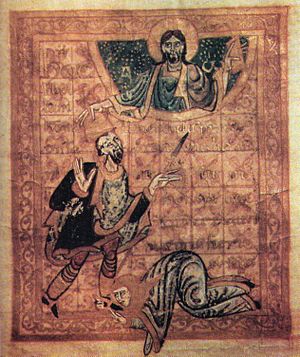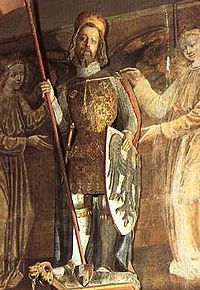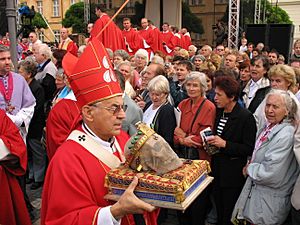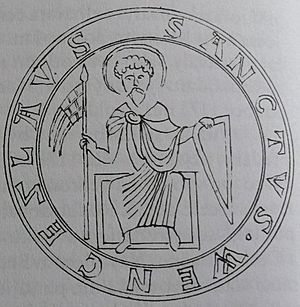Wenceslaus I, Duke of Bohemia facts for kids
Quick facts for kids Wenceslaus I |
|
|---|---|

Wenceslaus adored by his niece-in-law Emma (from the 10th-century Gumpold's Codex)
|
|
| Duke of Bohemia | |
| Reign | 13 February 921 − 28 September 935 or 929 |
| Predecessor | Vratislaus I |
| Successor | Boleslaus I |
| Born | c. 907 Stochov, Bohemia |
| Died | 28 September 935 (aged c. 28) or 28 September 929 (aged c. 22) Stará Boleslav, Bohemia |
| Burial | Basilica od St. Wenceslaus in Stará Boleslav, St. Vitus Cathedral in Prague |
| House | Přemyslid |
| Father | Vratislaus I |
| Mother | Drahomíra |
| Religion | Chalcedonian Christianity |
Wenceslaus I (Czech: Václav [ˈvaːtslaf] (![]() listen); born around 907 – died September 28, 935 or 929), also known as Wenceslas I or Václav the Good, was the Duke of Bohemia. He ruled from 921 until his death. Legend says he was killed by his younger brother, Boleslaus the Cruel.
listen); born around 907 – died September 28, 935 or 929), also known as Wenceslas I or Václav the Good, was the Duke of Bohemia. He ruled from 921 until his death. Legend says he was killed by his younger brother, Boleslaus the Cruel.
Wenceslaus became famous for his good deeds and was later recognized as a saint. He was declared a king after his death and is now the patron saint of the Czech state. You might know him from the popular Christmas carol, "Good King Wenceslas".
Contents
Who Was Wenceslaus I?
Wenceslaus was the son of Vratislaus I, who was a Duke of Bohemia from the Přemyslid family. His grandfather, Bořivoj I, became a Christian thanks to Cyril and Methodius. Wenceslaus's mother, Drahomíra, came from a non-Christian family but was baptized when she married. His grandmother, Ludmila of Bohemia, made sure he learned the Old Slavonic language. Wenceslaus was sent to a school in Budeč at a young age.
Early Life and Family Challenges
In 921, when Wenceslaus was about 13 years old, his father passed away. His grandmother, Ludmila, then became the ruler in his place. Drahomíra, Wenceslaus's mother, was jealous of Ludmila's influence over Wenceslaus. Because of this, Drahomíra arranged for Ludmila to be killed. Ludmila was first buried in a church, but her remains were later moved to the church of St. George in Prague. Wenceslaus's father had built this church.
After Ludmila's death, Drahomíra took over as regent. She started to act against Christians. When Wenceslaus turned 18, Christian nobles who supported him rebelled against Drahomíra. They succeeded, and Drahomíra was sent away to Budeč.
Wenceslaus Becomes Duke
With the support of the nobles, Wenceslaus became the ruler of Bohemia. He brought the local dukes back under control. He also used Christianity to make his state stronger.
At this time, the rulers of Bohemia faced challenges from the Magyars and the forces of King Henry I of Saxony. Henry had started campaigns into nearby lands. To resist Saxon rule, Wenceslaus's father had made an alliance with Duke Arnulf of Bavaria. However, this alliance ended when Arnulf and Henry made peace in 921.
In 929, King Henry I and Duke Arnulf attacked Prague. This attack forced Wenceslaus to start paying a tribute again. This tribute had first been demanded by King Arnulf of Carinthia in 895. Henry needed the money because he had to pay a large tribute to the Magyars himself. Another reason for the attack might have been an alliance between Bohemia, the Polabian Slavs, and the Magyars against the Saxons.
Wenceslaus brought German priests to his land. He preferred the Latin way of worship over the old Slavic one, which was not used much anymore. He also started building a church dedicated to St. Vitus at Prague Castle. This church is now the famous St. Vitus Cathedral.
How Wenceslaus Died
In September 935, some nobles who were allied with Wenceslaus's younger brother, Boleslav, killed Wenceslaus.
According to a historical book from the 12th century, one of Boleslav's sons was born on the day Wenceslaus died. Because of this sad event, the baby was named Strachkvas, which means "a dreadful feast."
Wenceslaus's loyal servant, Podevin, tried to get revenge. He killed one of the main people involved in Wenceslaus's death. For this, Boleslav had Podevin executed.
Why Wenceslaus Became a Saint
| Saint Wenceslaus I, Duke of Bohemia |
|
|---|---|

Statue of Saint Wenceslaus in St. Vitus Cathedral, Prague. The head of the statue apparently fits the measurements of Wenceslaus's skull.
|
|
| Martyr | |
| Born | c. 907 Prague, Bohemia |
| Died | 28 September 935 Stará Boleslav, Bohemia |
| Venerated in | Catholic Church and Eastern Orthodox Church |
| Major shrine | St. Vitus Cathedral, Prague |
| Feast | 28 September |
| Attributes | Crown, dagger, burning eagle on a banner |
| Patronage | Prague, Bohemia, Czech Republic |
Wenceslaus was seen as a martyr (someone who dies for their beliefs) and a saint right after his death. People in Bohemia and England started to honor him. Within a few decades, four biographies were written about him. These stories helped create the idea of a "righteous king." This was a ruler whose power came from being very religious and strong.
A historian named Cosmas of Prague wrote about Wenceslaus in 1119. He said that Wenceslaus would get up every night, walk barefoot to churches, and give money to people in need. He helped widows, orphans, and those in prison. Cosmas said Wenceslaus was seen "not as a prince, but the father of all the wretched."
Even though Wenceslaus was only a duke during his life, Holy Roman Emperor Otto I later gave him the title of "king." This is why he is called "king" in stories and songs.
The song "Svatý Václave" (Saint Wenceslaus) is one of the oldest Czech songs. It dates back to the 12th century and is still very popular. In 1918, when Czechoslovakia was founded, people even thought about making it the national anthem.
Wenceslaus's feast day is celebrated on September 28. On this day, people hold celebrations and a pilgrimage in Stará Boleslav. The day his remains were moved, March 4, is also remembered. Since 2000, September 28 has been a public holiday in the Czech Republic, known as Czech Statehood Day.
Legends About Wenceslaus

One legend tells of a count named Radislas who rebelled against King Wenceslaus. Wenceslaus offered peace, but Radislas thought this was a sign of fear. The two armies faced each other. To avoid a battle, Wenceslaus challenged Radislas to a one-on-one fight. As Radislas rode towards Wenceslaus, he saw two angels by Wenceslaus's side. They cried, "Stand off!" Radislas was shocked and immediately regretted his rebellion. He got off his horse, knelt before Wenceslaus, and asked for forgiveness. Wenceslaus forgave him and welcomed him back.
Another famous legend says that an army of knights sleeps under Blaník, a mountain in the Czech Republic. They will wake up and, led by Wenceslaus, help the Czech people when they are in great danger. A similar legend in Prague says that if the country is in danger, the statue of King Wenceslaus in Wenceslaus Square will come to life. He will raise the sleeping army from Blaník. When he crosses the Charles Bridge, his horse will trip over a stone, revealing the legendary sword of Bruncvík. With this sword, King Wenceslaus will defeat all enemies and bring peace to the land.
Wenceslaus's Legacy
Wenceslaus is the subject of the popular Christmas carol "Good King Wenceslas". This song was published in 1853 by John Mason Neale. It might be a translation of a poem by a Czech poet. It is important not to confuse him with King Wenceslaus I of Bohemia, who lived much later.
An equestrian statue of Saint Wenceslaus stands in Wenceslaus Square in Prague. It also features other important Czech saints. This statue is a popular meeting spot in Prague. Many protests against the Communist government were held there.
Wenceslaus's helmet and armor are displayed inside Prague Castle.
Wenceslaus in Popular Culture
The 1930 silent film St. Wenceslas was the most expensive Czech film made at that time.
The writer Ogden Nash wrote a funny poem in 1957 called "The Christmas that Almost Wasn't." In it, a boy wakes up Wenceslaus and his knights to save a kingdom where Christmas has been banned.
The 1994 TV movie Good King Wenceslas tells a fictional story about his early life. It stars Jonathan Brandis as Wenceslaus, with Leo McKern, Stefanie Powers, and Joan Fontaine as Ludmila.
See also
 In Spanish: Wenceslao I de Bohemia (duque) para niños
In Spanish: Wenceslao I de Bohemia (duque) para niños
- Crown of Saint Wenceslas
- Sword of Saint Wenceslas
- Statues of Saints Norbert, Wenceslaus and Sigismund
- Good King Wenceslas




